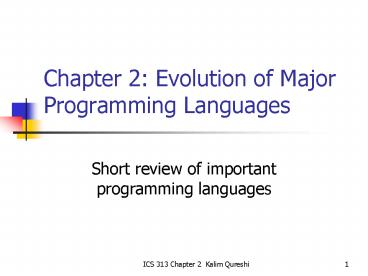Chapter 2: Evolution of Major Programming Languages - PowerPoint PPT Presentation
1 / 11
Title:
Chapter 2: Evolution of Major Programming Languages
Description:
Short review of important programming languages ... C is a system programming language. ... The basic data types are character strings and numbers whose precision is ... – PowerPoint PPT presentation
Number of Views:68
Avg rating:3.0/5.0
Title: Chapter 2: Evolution of Major Programming Languages
1
Chapter 2 Evolution of Major Programming
Languages
- Short review of important programming languages
2
Brief summary of following languages
3
Ada
- Ada is a large and powerful language based on
pascal. It includes features to support data
abstraction and concurrency. - An Ada is a collection of modules (subprograms or
packages). - A package is in two parts a specification which
gives its interface with the rest of the program,
a hidden implementation part. - Data types integer, float, character, Boolean
and string. - Type checking Ada is strong typed.
4
C
- C is a system programming language.
- C programs are comparable in efficiency to
assembly language programs. - The source text of a C program can be distributed
among several files, each of which can be
compiled independently. - Full type checking is not possible.
- The predefined data types are int, char and float
together with short and long and double. - User-defined types are enumeration types, arrays
and structure. - No concurrency support directly.
5
C
- C was designed to add object-oriented features
to C. - Classes support the decomposition of large
program into self-contained units. - Derived classes inherit the properties of a base
class which they can extend through the
definition of a new, or redefinition of existing,
data and function members. - Dynamic binding is supported.
- Type checking is supported.
- No concurrency support directly.
6
COBOL
- COBOL is the most extensively used programming
language in data processing and is oriented to
deal with large files of data. - A COBOL program is divided into four divisions.
IDENTIFICATION DIVISION, provides essential
program documentation the ENVIRONMENTAL DIVISION
contains machine-dependent program specifications
relating logical and physical entities the DATA
DIVISION describes the data and its structure
and finally, the PROCEDURE DIVISION gives the
algorithms. - The basic data types are character strings and
numbers whose precision is defined by the
programmer in DATA DIVISION. Array exist, but the
main structure variable are record. - Dynamic data structure are not supported.
- Implicit type checking are an integral part of
COBOL, little type checking is possible.
7
Eiffel
- Eiffel is an object-oriented language that
combines dynamic binding and static type
checking. - Programs are composed of class definitions. The
equivalent of a main program is the create
feature of the root class. - Simple data types such as integer, real,
character and boolean are built in. All other
types are defined using classes and are accessed
via pointer. - Strongly typed checking.
- No Concurrency support.
8
FORTRAN
- FORTRAN is still widely used for numerical
applications by scientists and engineers. - Recursion is not supported.
- INTEGER, REAL, DOUBLE PRECISION, LOGICAL, and
CHARACTER. - Supported type checking.
- Array can be passed as parameters.
- No concurrency support.
9
LISP
- LISP is primarily used in artificial intelligence
applications and although it is not a purely
functional language it has all the features
needed for functional programming. - The object manipulation in the language are
expression, which can be lists, atoms or
function. - Dynamic type checking.
- Recursion is used instead of iteration.
- No concurrency support.
10
Prolog
- PROLOG is a logic programming language.
- A PROLOG program consists of a database of facts
and a series of rules. - PROLOG has atoms,numbers and structures are data
types. - It is dynamic typed.
- Structure (which are similar to record in pascal)
- No concurrency support.
11
Smalltalk
- Object-oriented language. It is not just
language, but is a complete programming
environment. - Supports information hiding. Data local to an
object. - The only data type is the object. Object belong
to a class, which is itself an object. - When message are sent to an object, the required
method is selected dynamically at run time. - A concurrency is supported by collection of
concurrent object that communicate with one
another by sending messages.































